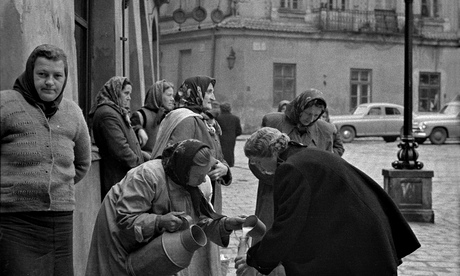
The photographer, historian and hispanophile Gerald Howson, who has died aged 88, had a zest for life and compassion for humanity, along with a meticulous eye for detail, that led him to excel in a number of fields. Only 10 days before he died, despite his evident frailty, he was surrounded by friends from the worlds of art, music and academia, at the opening of a remarkable exhibition of black and white photos that he had taken in Poland at the height of the cold war.
Gerald was born in the Cambridgeshire village of Buckden, but grew up in the East End of London, where his father, Vincent, previously an actor, was an Anglican vicar in Limehouse; his mother, Kate, was the daughter of the housekeeper at the Savoy hotel in the West End. The Howsons' home was destroyed in the blitz, which triggered a lifelong interest in military aircraft in the then 14-year-old Gerald, culminating in one of his later books, Aircraft of the Spanish Civil War (1990).
The family was relocated to the congenial parish of the actors' church, St Paul's, Covent Garden, where Gerald got his first real taste of bohemia. To his mother's dismay, the boy would invite rough sleepers in to bed down for the night in the vicarage when the weather was bad.
He did his military service in Palestine during the tumultuous period at the end of the British mandate, leading to the creation of the state of Israel and the subsequent Arab-Israeli war. But by this stage he knew that his main interest lay in the creative arts. He signed up at the Chelsea School of Art, focusing on painting, but also developed a passion for Spanish guitar music, particularly flamenco. In 1954, he took up a position teaching English in Spain, first in Vigo, Galicia, and later in Cádiz, Andalucía, throwing himself into the exuberant life of flamenco musicians and Gypsy culture, which would give him the necessary material for his flamboyantly candid memoir (and first published book), The Flamencos of Cádiz Bay (1965).
Though Gerald could hardly string two words of Spanish together when he first arrived in Franco's Spain, by the time he left a couple of years later he was fluent in the language and also an accomplished flamenco guitarist. He earned a modest living playing in clubs and other venues back in London, which is how he met his future wife, Vera, beginning a loving partnership that would last for 55 years and produce two children, Rebecca and Robert.
With growing family responsibilities, Gerald bought himself a camera and decided to try to carve out a career as a photojournalist. One of his first assignments was in Poland in 1959, to illustrate a feature in Queen magazine, for which a friend, the novelist Frank Tuohy (then working for the British Council in Warsaw), had been commissioned to write the text. The article was never published, and Gerald's pictures remained unseen by the public until half a century later, when they appeared in the exhibition and associated book, Gerald Howson: A Very Polish Affair (2014). When he showed some of his prints to the Polish embassy's cultural attache on his return to London from the abortive trip and she asked angrily where all the smiling faces were, he replied drily that there weren't any.
Gerald took up more stable employment, teaching part-time as head of photography at Wimbledon College of Art, where he remained until his retirement in 1992. He devoted increasing amounts of time to researching conflict situations and crime, and writing history books, including Thief-Taker General: The Rise and Fall of Jonathan Wild (1970) and Arms for Spain: The Untold Story of the Spanish Civil War (1998). The latter argued a thesis, contested by some leftwing scholars, that the republicans had been cynically exploited by Soviet Russia, which made them pay for second-rate weapons with gold. Gerald was working on a revised edition of the book when he died, and he could sometimes be spotted sitting on a bench at Charing Cross station, carefully amending footnotes.
He is survived by Vera, Rebecca and Robert.
• Gerald Howson, photographer, musician and writer, born 29 November 1925; died 7 June 2014

